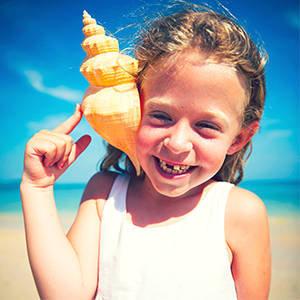Who wants to go to the beach? This question is almost always answered
with “ME!” in our family. During the summer, we pack up our beach
buggy, a large cart which holds just about everything, and either spend
the day with our toes in the sand or surf.
Spending multiple hours by the ocean with my curious children has led
to many inquiries about their surroundings. Often I have no idea what
the answer is so I end up saying, “I don’t know.” My daughter once said
to me, “Do you know anything about the beach and ocean?”
I created this list of questions and answers so unlike me, you will
know the correct response and hopefully prevent your children from
wondering if you passed high school science class (for the record I got
an A in Biology). Besides helping you appear smart to your children,
you can also use this list to create a trivia game.
Why does it sound like the ocean when you hold a shell up to your
ear?
It is actually the sound of your own ear fluid being echoed back to
you.- How are seashells made?
One common type of seashell is the one found on clams. To create the
shell the clam takes in salt and chemicals from the ocean water. The
clam uses these materials to produce calcium carbonate, which is
secreted on the outside of their bodies and hardens to create a shell. - How is sea glass made?
Sea glass is the result of people discarding glass into the ocean. It
can take decades before the glass becomes smooth. This process is a
result of the glass being tossed around by the ocean waves and dragged
against the sand. - Is sea glass worth money?
It can be. Similar to gems, it depends on different factors such as
color and shape. One piece of sea glass has sold for over $1,000. - What is the most common color of sea glass?
The most common colors of sea glass are white, green and brown.
- What is the rarest color of sea glass?
The rarest colors of sea glass are red, orange and yellow.
- Are there different types of seagulls?
What most people call a seagull is actually called a Herring Gull. The
Herring Gull can differ in size and color depending on the age. Adults
are mostly white with a gray back, and babies are brown. These types of
birds are scavengers and are usually found near food. There is also
another type of bird called the Great Black-backed Gull, which is found
along the coasts and looks similar to the Herring Gull. This bird is
the largest gull in the world. There are two dozen different species of
gulls living in North America. - How can the seagulls drink the sea water?
The seagull has special glands in their eyes that allow them to excrete
the salt. - Do seagulls have nests and lay eggs?
Yes, seagulls lay eggs and have nests. Seagulls often place the nest
near a rock, log or bush to protect it from predators and strong wind. - Is a starfish a fish?
It is actually called a sea star and is not a starfish. Sea stars do
not have fins or gills like fish. This type of creature is an
Echinodermata, which is in the same category as a sand dollar, sea
urchin and sea cucumbers. A fun fact about a sea star is that they can
regenerate arms. - Why do the tides change?
Tides change is caused by the gravitational pull of the sun and the
moon, as well as the earth’s rotation. - How do people know the times of low and high tides?
Creating a tide chart with the times of high and low tides is not an
exact science. Factors such as ocean current, winds and the contour of
the ocean bottom can all influence what time a high or low tide will
occur. The official source in the United States for predicting tides is
the Center for Operational Oceanographic Products and Services
(CO-OPS). There are 140 tide stations that measure tide levels, wind
speed and direction, water current speed and directions, air and water
temperatures and barometric pressure. These measurements collected
together create the tidal chart times. - What causes ocean waves?
Waves are the result of winds moving over the ocean surface. Friction
between the air and water transfers the energy between air and water.
The transfer of energy is what creates the wave. - How is sand on the beach created?
Sand is comprised mostly from quartz rocks. The rocks were broken down
by wind and rain and then transported to the beach by water. - What causes an ocean sandbar?
An ocean sandbar is created by waves pulling the sand farther into the
ocean. When there is a storm or large waves, a sandbar can form farther
from the shoreline. If there are many large waves or storms, a barrier
island can form.
How to Encourage Your Future Marine Biologist
If your children are interested in marine biology and ecology, you can
go to your local library and borrow books on the topic. For example,
there are books about conducting science experiments or identifying
different types of ocean organisms. Our favorite books are about
beachcombing.
What questions do your kids ask you when you are at the beach?


